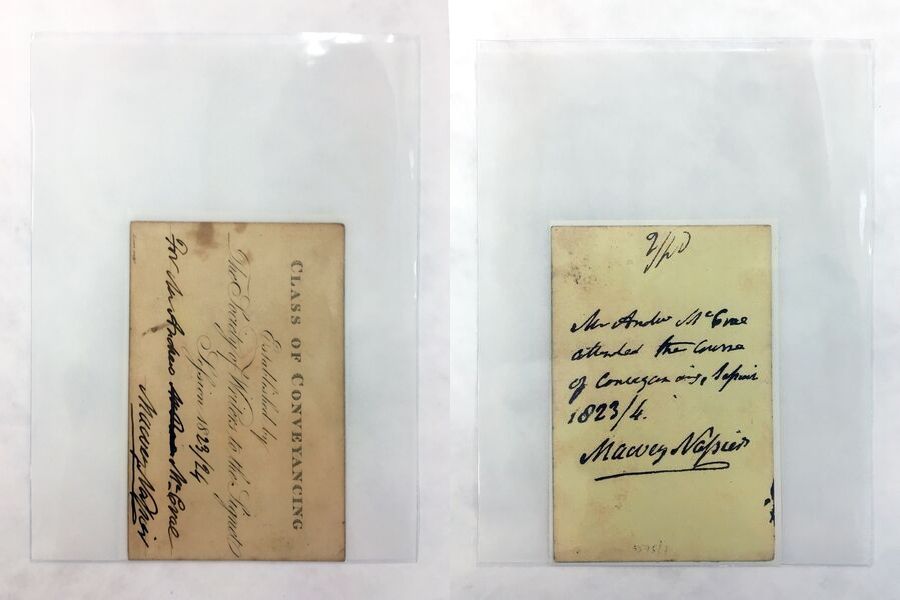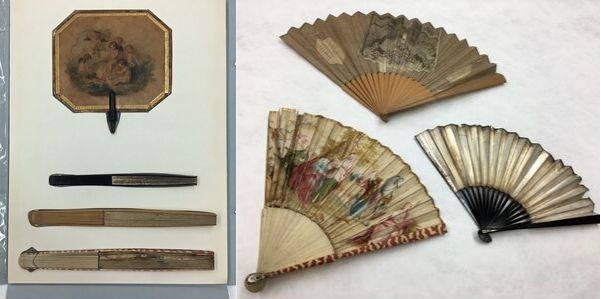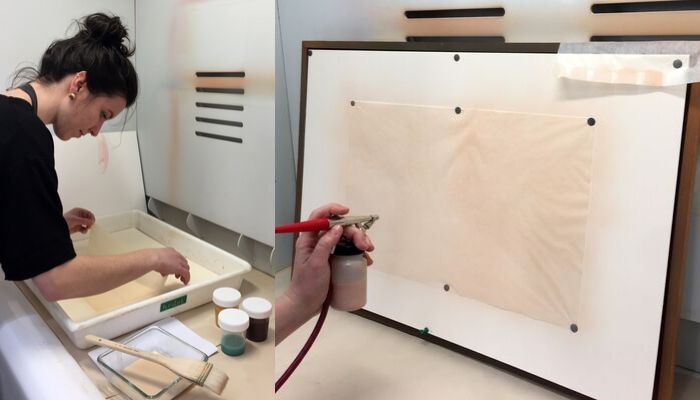Kathleen Rowbottom, Professional Placement, Conservation, Collections Care.
The papers of the McCrae family collection are extensive and feature a range of different objects: from bound volumes such as scrapbooks, diaries and published works, to watercolour paintings and art materials, cased photographs, personal letters, and domestic objects including fans, purses and coins. This fascinating collection spans three generations: Georgiana Huntly McCrae (1804-1890), George Gordon McCrae (1833-1927), and Hugh Raymond McCrae (1876-1958).
Georgiana Huntly McCrae was a key figure during the settlement years of Victoria, Australia. Born out of wedlock in London to a Scottish aristocrat, the 5th Duke of Gordon, Georgiana went on to become a significant artist and diarist. In 1830 Georgiana married Andrew Murison McCrae and in 1841 she, with their four children, joined her husband in Australia. The papers of the McCrae family contain Georgiana’s numerous diaries, journals and sketchbooks, which illustrate what life was like in Colonial Victoria. Georgiana lived a life less ordinary than most, defying the odds as a woman, settler and artist, and due to her exceptional talent as a miniaturist and watercolourist, she is now considered a significant artist of her time.
Today the McCrae family collection (MS 12831) lives in the Manuscripts Collection at the State Library Victoria where it provides a valuable resource for all.

Figure 1 & 2: A fan from the papers of the McCrae family collection that features glittering silver and gold toned sides (Manuscripts Collection, MS 12831, Box F3598).
Collection survey
A collection survey is an extremely valuable tool for both Conservators and collection staff. It allows us to categorise objects according to certain features, material type, condition or treatment requirements, and is a useful tool in determining the overall preservation and treatment approach for large and complex collections. In view of the breadth and diversity of the papers of the McCrae family, we decided to embark upon a collection survey to assess its general condition, determine its storage requirements and prioritise future conservation treatments.
During the survey we noted that many objects displayed deterioration consistent with regular use during their lifetime. For example, the papers exhibit surface dirt, creases and edge tears common to regularly accessed materials. This survey also enabled us to compare different objects and their condition to determine best practice for future conservation treatment, including the most suitable methods of cleaning, or whether repairs are necessary for safe handling. In some cases, it was determined that objects required unfolding and flattening, which would expand their size and therefore the scale of their housing. Our survey allowed the conservation team to consider more sensitive object housing that would help to simplify and reduce the storage footprint of this collection.

Figure 3: Inserting a toned ‘infill’ to stabilise a letter from Carrie Chevalier to Georgiana McCrae, 1878 (Manuscripts Collection, MS 12831, Box F3590/4-i).
Highlights: different object, different approach
Based on information revealed during the collection survey, the conservation team was able to prioritise and embark upon a range of conservation treatment and rehousing projects. Following is a selection of different conservation approaches for this complex collection.
University library cards and attendance certificates: an exercise in minimal intervention
Within the discipline of conservation, we often discuss the notion of ‘minimal intervention’. As conservators, we have a professional and ethical responsibility to ensure the objects in our care are not only stabilised, but also that their significance and meaning is not altered through our work. This concept came into play with the cleaning and rehousing of attendance certificates and library cards belonging to Andrew Murison McCrae during his time at Edinburgh University in the early 1800s.

Figure 4: Library cards and university certificates belonging to Andrew Murison McCrae, early 1800s (Manuscripts Collection, MS 12831, Box F3595-1).
Students would receive certificates as evidence of their class attendance as well as library cards to enable the borrowing of books. These were very common objects at the time and would have been handled regularly by Andrew McCrae, resulting in general abrasion and staining. As archival material, the significance of these items lies primarily in their informational content. During assessment it was determined that the damage does not restrict the viewing of their printed information, therefore it was unnecessary to undertake stain reduction that may reduce original evidence of use. Conservation treatment involved gentle surface cleaning to remove loose surface dirt, and rehousing in archival enclosures to protect the objects into the future. In addition, to minimise handling of the objects, double-sided certificates and library cards were placed in polypropylene sleeves on support sheets and a printed image of each object’s reverse side was inserted behind. As a result, viewers will no longer need to touch the items directly to read the information they contain. We believe that preserving these objects in an authentic state is integral to maintaining their significance.

Figure 5: Attendance certificate for the Class of Conveyancing, 1823-24, rehoused in its polypropylene sleeve with support sheet (Manuscripts Collection, MS 12831, Box F3595-1).
Figure 6: Printed image of the certificate’s reverse side, inserted on the opposite side of the support sheet.
Handheld folding fans: reconsidering traditional storage techniques
As conservators our techniques, methods and materials have developed over time to better achieve treatment and storage objectives. In the papers of the McCrae family, we came across four folding fans housed together in a box; one features possible silver and gold gilding with lacquered timber ‘monture’ (the structural skeleton of the fan), another is made of ivory with the highly publicised trial of Warren Hastings painted across its ‘leaf’ (the flexible fabric that joins the skeleton and provides an aesthetic outer-cover for the fan). These fans were housed closed, however we decided it was worth reassessing whether this was in fact the most efficient and stable option for the future.
Folding fans are unique objects as they are created with dual purpose, intended both for use as practical tools and to be enjoyed as aesthetic objects. It was expected that the fans found in this collection would show wear and tear typical of an historic object with delicate moving parts, in particular that the fans may have embrittled, experienced shrinking, discolouration or warping with age. Therefore, great care and patience was taken when opening each item. The leaf of the ivory fan proved to be less stable than the others, showing signs of damage along its folds possibly due to repeated opening and closing throughout its life. As the primary feature of this fan – its painted design – could not be properly viewed without being actively opened by the viewer, it was important to consider whether the fan should instead be stored in an open configuration to minimise damage that might be sustained through future handling. When fans are housed in this way, it is imperative that they have adequate support and the leaf is not under tension between the rods. In this case, we intend to support the open fan on a custom archival support within a custom box. The box will be labelled clearly to indicate the presence of fragile materials and the correct orientation for storage and handling.

Figure 7: Fans belonging to the McCrae family in their previous housing (Manuscripts Collection, MS 12831, Box F3598).
Figure 8: Fans belonging to the McCrae family in an open configuration (Manuscripts Collection, MS 12831, Box F3598).
The artist’s scrapbook: aesthetic significance at the fore
When an object of artistic value is torn, stained or otherwise damaged, the viewer can become distracted by its condition rather than being drawn to its intended focus. This not only affects the aesthetic interpretation of the object, but as a result, it also alters the object’s significance or meaning. When assessing one of several scrapbooks belonging to Georgiana McCrae during the collection survey, we found that many pages were damaged in such a way that detracted from the artistic intent. The scrapbook pages were originally manufactured in different hues of blue, pink and beige, onto which many paintings, sketches, articles and cut-outs are adhered. As this scrapbook was assembled by Georgiana herself, it is evident that there was artistic intent behind the way each item was laid out within the book. Therefore, it was deemed necessary to return aesthetic continuity to the scrapbook pages.
In order to both stabilise and draw the viewer’s eye away from the damage, it was decided in consultation with the collection manager that cosmetic repairs should be completed using paper toned to match the coloured pages. To do this we diluted acrylic paints in deionised water and methodically mixed the colours, drop by drop, until we reached the ideal solution. Next, we used two different techniques to apply the solution to the Japanese kōzo paper chosen for mending. The first method used a soft brush to apply the colour in a cross-hatching technique: applying strokes along the length, drying, then applying strokes across the width, and repeating until a rich and even finish was achieved. The second method used the airbrush, a tool perhaps better known in the fields of art and illustration. Although this process was much slower, applying a finer mist of colour, it achieved a very even result. The repairs were shaped from the toned paper using a water pen and adhered to the torn pages using diluted wheat starch paste. As we had hoped, the repairs successfully fade into the background, effectively stabilising and visually reintegrating the contents of the scrapbook.

Figure 9: Carefully re-tensioning the paper while brush-toning for a beige repair paper.
Figure 10: Using the airbrush to create a pink repair paper.

Figure 11: Assessing the colour of the beige repair paper against damaged pages in Georgiana McCrae’s scrapbook (Manuscripts Collection, MS 12831, Box F3591/6 & 6a).
Figure 12: Mending a damaged page using pink repair paper in Georgiana McCrae’s scrapbook (Manuscripts Collection, MS 12831, Box F3591/6 & 6a).
The McCrae family collection contains a wide range of objects and materials. The objective of this project was to gain a greater insight into this collection and its material makeup, and to make it more accessible to the public. This survey identified the different conservation approaches required to effectively preserve this collection and will provide an invaluable basis for its ongoing conservation treatment and rehousing needs into the future.
This project was completed by Kathleen Rowbottom during her professional placement with the Conservation department at the State Library Victoria. This placement was organised in conjunction with the University of Melbourne as part of the professional practice requirement of the Master of Cultural Materials Conservation course.
Other resources:
- Visit the Library’s Changing face of Victoria exhibition in the Dome galleries to learn more about Georgiana McCrae.
- Listen to one of our conservators talk about Georgiana McCrae’s paintbox and easel, which are currently on display in the Changing face of Victoria exhibition.
- Check out our conservation Instagram post, which highlights the life and artwork of Georgiana McCrae.


Hello.
I wonder if you could help me find any reference in the Mc Crae family papers to Susannah Mc Crae ( nee Dunaway) ?
I am her GT GT Niece researching her story here in England.
Many thanks
Marie
Hello Marie, I will log your question with our Ask a Librarian service and someone will get back to you. Kind regards, Paul.